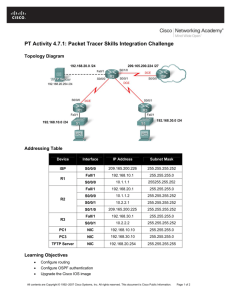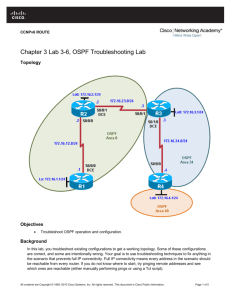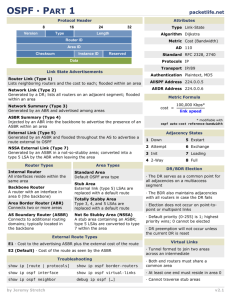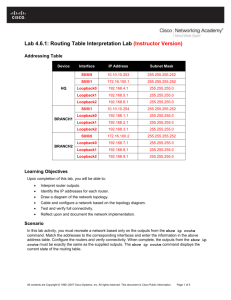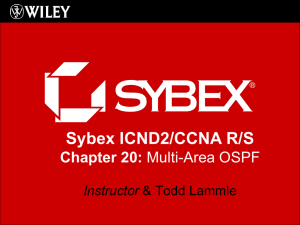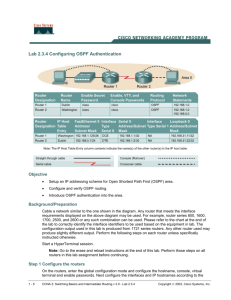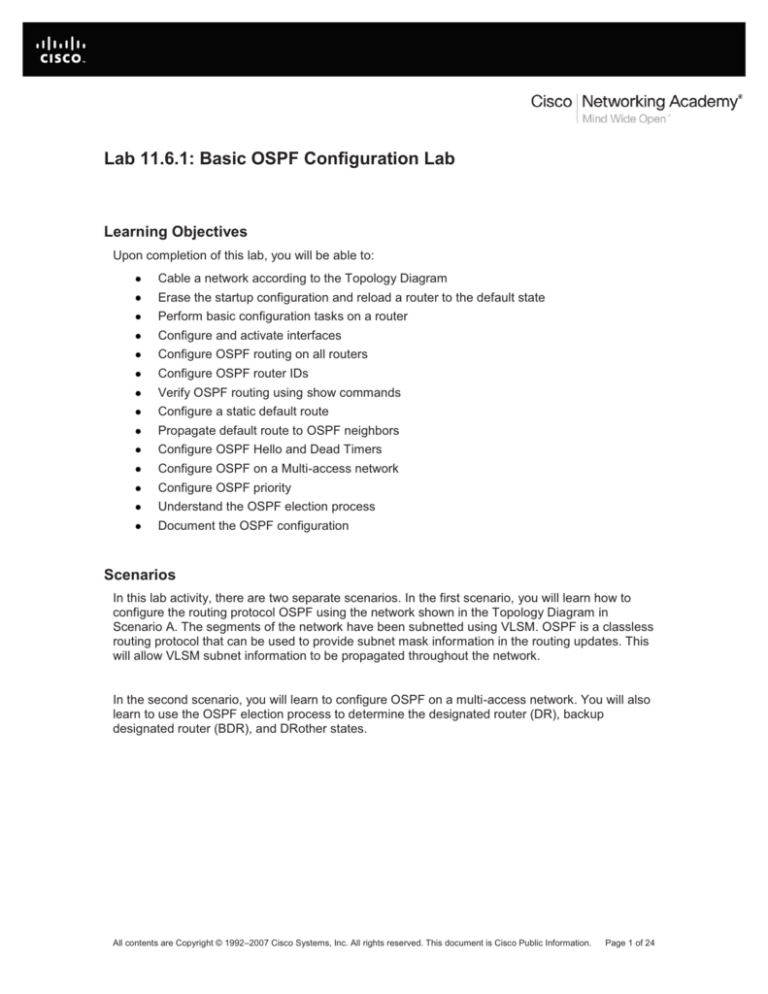
Lab 11.6.1: Basic OSPF Configuration Lab
Learning Objectives
Upon completion of this lab, you will be able to:
Cable a network according to the Topology Diagram
Erase the startup configuration and reload a router to the default state
Perform basic configuration tasks on a router
Configure and activate interfaces
Configure OSPF routing on all routers
Configure OSPF router IDs
Verify OSPF routing using show commands
Configure a static default route
Propagate default route to OSPF neighbors
Configure OSPF Hello and Dead Timers
Configure OSPF on a Multi-access network
Configure OSPF priority
Understand the OSPF election process
Document the OSPF configuration
Scenarios
In this lab activity, there are two separate scenarios. In the first scenario, you will learn how to
configure the routing protocol OSPF using the network shown in the Topology Diagram in
Scenario A. The segments of the network have been subnetted using VLSM. OSPF is a classless
routing protocol that can be used to provide subnet mask information in the routing updates. This
will allow VLSM subnet information to be propagated throughout the network.
In the second scenario, you will learn to configure OSPF on a multi-access network. You will also
learn to use the OSPF election process to determine the designated router (DR), backup
designated router (BDR), and DRother states.
All contents are Copyright © 1992–2007 Cisco Systems, Inc. All rights reserved. This document is Cisco Public Information.
Page 1 of 24
CCNA Exploration
Routing Protocols and Concepts: OSPF
Lab 11.6.1: Basic OSPF Configuration Lab
Scenario A: Basic OSPF Configuration
Topology Diagram
Addressing Table
Interface
IP Address
Subnet Mask
Default
Gateway
Fa0/0
172.16.1.17
255.255.255.240
N/A
S0/0/0
192.168.10.1
255.255.255.252
N/A
S0/0/1
192.168.10.5
255.255.255.252
N/A
Fa0/0
10.10.10.1
255.255.255.0
N/A
S0/0/0
192.168.10.2
255.255.255.252
N/A
S0/0/1
192.168.10.9
255.255.255.252
N/A
Fa0/0
172.16.1.33
255.255.255.248
N/A
S0/0/0
192.168.10.6
255.255.255.252
N/A
S0/0/1
192.168.10.10
255.255.255.252
N/A
PC1
NIC
172.16.1.20
255.255.255.240
172.16.1.17
PC2
NIC
10.10.10.10
255.255.255.0
10.10.10.1
PC3
NIC
172.16.1.35
255.255.255.248
172.16.1.33
Device
R1
R2
R3
Task 1: Prepare the Network.
Step 1: Cable a network that is similar to the one in the Topology Diagram.
You can use any current router in your lab as long as it has the required interfaces shown in the
topology.
All contents are Copyright © 1992–2007 Cisco Systems, Inc. All rights reserved. This document is Cisco Public Information.
Page 2 of 24
CCNA Exploration
Routing Protocols and Concepts: OSPF
Lab 11.6.1: Basic OSPF Configuration Lab
Note: If you use 1700, 2500, or 2600 routers, the router outputs and interface descriptions will
appear different.
Step 2: Clear any existing configurations on the routers.
Task 2: Perform Basic Router Configurations.
Perform basic configuration of the R1, R2, and R3 routers according to the following guidelines:
1. Configure the router hostname.
2. Disable DNS lookup.
3. Configure a privileged EXEC mode password.
4. Configure a message-of-the-day banner.
5. Configure a password for console connections.
6. Configure a password for VTY connections.
Task 3: Configure and Activate Serial and Ethernet Addresses.
Step 1: Configure interfaces on R1, R2, and R3.
Configure the interfaces on the R1, R2, and R3 routers with the IP addresses from the table
under the Topology Diagram.
Step 2: Verify IP addressing and interfaces.
Use the show ip interface brief command to verify that the IP addressing is correct and
that the interfaces are active.
When you have finished, be sure to save the running configuration to the NVRAM of the router.
Step 3: Configure Ethernet interfaces of PC1, PC2, and PC3.
Configure the Ethernet interfaces of PC1, PC2, and PC3 with the IP addresses and default
gateways from the table under the Topology Diagram.
Step 4: Test the PC configuration by pinging the default gateway from the PC.
Task 4: Configure OSPF on the R1 Router
Step 1: Use the router ospf command in global configuration mode to enable OSPF on the
R1 router. Enter a process ID of 1 for the process-ID parameter.
R1(config)#router ospf 1
R1(config-router)#
Step 2: Configure the network statement for the LAN network.
Once you are in the Router OSPF configuration sub-mode, configure the LAN network
172.16.1.16/28 to be included in the OSPF updates that are sent out of R1.
The OSPF network command uses a combination of network-address and wildcard-mask
similar to that which can be used by EIGRP. Unlike EIGRP, the wildcard mask in OSPF is
required.
All contents are Copyright © 1992–2007 Cisco Systems, Inc. All rights reserved. This document is Cisco Public Information.
Page 3 of 24
CCNA Exploration
Routing Protocols and Concepts: OSPF
Lab 11.6.1: Basic OSPF Configuration Lab
Use an area ID of 0 for the OSPF area-id parameter. 0 will be used for the OSPF area ID in all
of the network statements in this topology.
R1(config-router)#network 172.16.1.16 0.0.0.15 area 0
R1(config-router)#
Step 3: Configure the router to advertise the 192.168.10.0/30 network attached to the
Serial0/0/0 interface.
R1(config-router)# network 192.168.10.0 0.0.0.3 area 0
R1(config-router)#
Step 4: Configure the router to advertise the 192.168.10.4/30 network attached to the
Serial0/0/1 interface.
R1(config-router)# network 192.168.10.4 0.0.0.3 area 0
R1(config-router)#
Step 5: When you are finished with the OSPF configuration for R1, return to privileged
EXEC mode.
R1(config-router)#end
%SYS-5-CONFIG_I: Configured from console by console
R1#
Task 5: Configure OSPF on the R2 and R3 Routers
Step 1: Enable OSPF routing on the R2 router using the router ospf command.
Use a process ID of 1.
R2(config)#router ospf 1
R2(config-router)#
Step 2: Configure the router to advertise the LAN network 10.10.10.0/24 in the OSPF
updates.
R2(config-router)#network 10.10.10.0 0.0.0.255 area 0
R2(config-router)#
Step 3: Configure the router to advertise the 192.168.10.0/30 network attached to the
Serial0/0/0 interface.
R2(config-router)#network 192.168.10.0 0.0.0.3 area 0
R2(config-router)#
00:07:27: %OSPF-5-ADJCHG: Process 1, Nbr 192.168.10.5 on Serial0/0/0
from EXCHANGE to FULL, Exchange Done
Notice that when the network for the serial link from R1 to R2 is added to the OSPF configuration,
the router sends a notification message to the console stating that a neighbor relationship with
another OSPF router has been established.
All contents are Copyright © 1992–2007 Cisco Systems, Inc. All rights reserved. This document is Cisco Public Information.
Page 4 of 24
CCNA Exploration
Routing Protocols and Concepts: OSPF
Lab 11.6.1: Basic OSPF Configuration Lab
Step 4: Configure the router to advertise the 192.168.10.8/30 network attached to the
Serial0/0/1 interface.
When you are finished, return to privileged EXEC mode.
R2(config-router)#network 192.168.10.8 0.0.0.3 area 0
R2(config-router)#end
%SYS-5-CONFIG_I: Configured from console by console
R2#
Step 5: Configure OSPF on the R3 router using the router ospf and network
commands.
Use a process ID of 1. Configure the router to advertise the three directly connected networks.
When you are finished, return to privileged EXEC mode.
R3(config)#router ospf 1
R3(config-router)#network 172.16.1.32 0.0.0.7 area 0
R3(config-router)#network 192.168.10.4 0.0.0.3 area 0
R3(config-router)#
00:17:46: %OSPF-5-ADJCHG: Process 1, Nbr 192.168.10.5 on Serial0/0/0
from LOADING to FULL, Loading Done
R3(config-router)#network 192.168.10.8 0.0.0.3 area 0
R3(config-router)#
00:18:01: %OSPF-5-ADJCHG: Process 1, Nbr 192.168.10.9 on Serial0/0/1
from EXCHANGE to FULL, Exchange Done
R3(config-router)#end
%SYS-5-CONFIG_I: Configured from console by console
R3#
Notice that when the networks for the serial links from R3 to R1 and R3 to R2 are added to the
OSPF configuration, the router sends a notification message to the console stating that a
neighbor relationship with another OSPF router has been established.
Task 6: Configure OSPF Router IDs
The OSPF router ID is used to uniquely identify the router in the OSPF routing domain. A router
ID is an IP address. Cisco routers derive the Router ID in one of three ways and with the following
precedence:
1. IP address configured with the OSPF router-id command.
2. Highest IP address of any of the router’s loopback addresses.
3. Highest active IP address on any of the router’s physical interfaces.
Step 1: Examine the current router IDs in the topology.
Since no router IDs or loopback interfaces have been configured on the three routers, the router
ID for each router is determined by the highest IP address of any active interface.
What is the router ID for R1? ____________________
What is the router ID for R2? ____________________
What is the router ID for R3? ____________________
All contents are Copyright © 1992–2007 Cisco Systems, Inc. All rights reserved. This document is Cisco Public Information.
Page 5 of 24
CCNA Exploration
Routing Protocols and Concepts: OSPF
Lab 11.6.1: Basic OSPF Configuration Lab
The router ID can also be seen in the output of the show ip protocols, show ip ospf, and
show ip ospf interfaces commands.
R3#show ip protocols
Routing Protocol is "ospf 1"
Outgoing update filter list for all interfaces is not set
Incoming update filter list for all interfaces is not set
Router ID 192.168.10.10
Number of areas in this router is 1. 1 normal 0 stub 0 nssa
Maximum path: 4
<output omitted>
R3#show ip ospf
Routing Process "ospf 1" with ID 192.168.10.10
Supports only single TOS(TOS0) routes
Supports opaque LSA
SPF schedule delay 5 secs, Hold time between two SPFs 10 secs
<output omitted>
R3#show ip ospf interface
FastEthernet0/0 is up, line protocol is up
Internet address is 172.16.1.33/29, Area 0
Process ID 1, Router ID 192.168.10.10, Network Type BROADCAST, Cost:
1
Transmit Delay is 1 sec, State DR, Priority 1
Designated Router (ID) 192.168.10.10, Interface address 172.16.1.33
No backup designated router on this network
Timer intervals configured, Hello 10, Dead 40, Wait 40, Retransmit 5
Hello due in 00:00:00
Index 1/1, flood queue length 0
Next 0x0(0)/0x0(0)
Last flood scan length is 1, maximum is 1
Last flood scan time is 0 msec, maximum is 0 msec
Neighbor Count is 0, Adjacent neighbor count is 0
Suppress hello for 0 neighbor(s)
<output omitted>
R3#
Step 2: Use loopback addresses to change the router IDs of the routers in the topology.
R1(config)#interface loopback 0
R1(config-if)#ip address 10.1.1.1 255.255.255.255
R2(config)#interface loopback 0
R2(config-if)#ip address 10.2.2.2 255.255.255.255
R3(config)#interface loopback 0
R3(config-if)#ip address 10.3.3.3 255.255.255.255
All contents are Copyright © 1992–2007 Cisco Systems, Inc. All rights reserved. This document is Cisco Public Information.
Page 6 of 24
CCNA Exploration
Routing Protocols and Concepts: OSPF
Lab 11.6.1: Basic OSPF Configuration Lab
Step 3: Reload the routers to force the new Router IDs to be used.
When a new Router ID is configured, it will not be used until the OSPF process is restarted. Make
sure that the current configuration is saved to NRAM, and then use the reload command to
restart each of the routers..
When the router is reloaded, what is the router ID for R1? ____________________
When the router is reloaded, what is the router ID for R2? ____________________
When the router is reloaded, what is the router ID for R3? ____________________
Step 4: Use the show ip ospf neighbors command to verify that the router IDs have
changed.
R1#show ip ospf neighbor
Neighbor ID
Interface
10.3.3.3
Serial0/0/1
10.2.2.2
Serial0/0/0
Pri
0
0
State
FULL/
FULL/
Dead Time
-
00:00:30
-
Address
192.168.10.6
00:00:33
192.168.10.2
Dead Time
Address
R2#show ip ospf neighbor
Neighbor ID
Interface
10.3.3.3
Serial0/0/1
10.1.1.1
Serial0/0/0
Pri
State
0
FULL/
-
00:00:36
192.168.10.10
0
FULL/
-
00:00:37
192.168.10.1
Dead Time
Address
R3#show ip ospf neighbor
Neighbor ID
Interface
10.2.2.2
Serial0/0/1
10.1.1.1
Serial0/0/0
Pri
State
0
FULL/
-
00:00:34
192.168.10.9
0
FULL/
-
00:00:38
192.168.10.5
Step 5: Use the router-id command to change the router ID on the R1 router.
Note: Some IOS versions do not support the router-id command. If this command is not
available, continue to Task 7.
R1(config)#router ospf 1
R1(config-router)#router-id 10.4.4.4
Reload or use “clear ip ospf process” command, for this to take effect
If this command is used on an OSPF router process which is already active (has neighbors), the
new router-ID is used at the next reload or at a manual OSPF process restart. To manually restart
the OSPF process, use the clear ip ospf process command.
All contents are Copyright © 1992–2007 Cisco Systems, Inc. All rights reserved. This document is Cisco Public Information.
Page 7 of 24
CCNA Exploration
Routing Protocols and Concepts: OSPF
Lab 11.6.1: Basic OSPF Configuration Lab
R1#(config-router)#end
R1# clear ip ospf process
Reset ALL OSPF processes? [no]:yes
R1#
Step 6: Use the show ip ospf neighbor command on router R2 to verify that the router
ID of R1 has been changed.
R2#show ip ospf neighbor
Neighbor ID
Interface
10.3.3.3
Serial0/0/1
10.4.4.4
Serial0/0/0
Pri
State
0
FULL/
0
FULL/
Dead Time
Address
-
00:00:36
192.168.10.10
-
00:00:37
192.168.10.1
Step 7: Remove the configured router ID with the no form of the router-id command.
R1(config)#router ospf 1
R1(config-router)#no router-id 10.4.4.4
Reload or use “clear ip ospf process” command, for this to take effect
Step 8: Restart the OSPF process using the clear ip ospf process command.
Restarting the OSPF process forces the router to use the IP address configured on the Loopback
0 interface as the Router ID.
R1(config-router)#end
R1# clear ip ospf process
Reset ALL OSPF processes? [no]:yes
R1#
Task 7: Verify OSPF Operation
Step 1: On the R1 router, Use the show ip ospf neighbor command to view the
information about the OSPF neighbor routers R2 and R3. You should be able to see the
neighbor ID and IP address of each adjacent router, and the interface that R1 uses to reach that
OSPF neighbor.
R1#show ip ospf neighbor
Neighbor ID
Pri
State
Interface
10.2.2.2
0
FULL/Serial0/0/0
10.3.3.3
0
FULL/Serial0/0/1
R1#
Dead Time
Address
00:00:32
192.168.10.2
00:00:32
192.168.10.6
Step 2: On the R1 router, use the show ip protocols command to view information
about the routing protocol operation.
Notice that the information that was configured in the previous Tasks, such as protocol, process
ID, neighbor ID, and networks, is shown in the output. The IP addresses of the adjacent
neighbors are also shown.
All contents are Copyright © 1992–2007 Cisco Systems, Inc. All rights reserved. This document is Cisco Public Information.
Page 8 of 24
CCNA Exploration
Routing Protocols and Concepts: OSPF
Lab 11.6.1: Basic OSPF Configuration Lab
R1#show ip protocols
Routing Protocol is "ospf 1"
Outgoing update filter list for all interfaces is not set
Incoming update filter list for all interfaces is not set
Router ID 10.1.1.1
Number of areas in this router is 1. 1 normal 0 stub 0 nssa
Maximum path: 4
Routing for Networks:
172.16.1.16 0.0.0.15 area 0
192.168.10.0 0.0.0.3 area 0
192.168.10.4 0.0.0.3 area 0
Routing Information Sources:
Gateway
Distance
Last Update
10.2.2.2
110
00:11:43
10.3.3.3
110
00:11:43
Distance: (default is 110)
R1#
Notice that the output specifies the process ID used by OSPF. Remember, the process ID must
be the same on all routers for OSPF to establish neighbor adjacencies and share routing
information.
Task8: Examine OSPF Routes in the Routing Tables
View the routing table on the R1 router. OSPF routes are denoted in the routing table with an “O”.
R1#show ip route
Codes: C - connected, S - static, I - IGRP, R - RIP, M - mobile, B BGP
D - EIGRP, EX - EIGRP external, O - OSPF, IA - OSPF inter area
N1 - OSPF NSSA external type 1, N2 - OSPF NSSA external type 2
E1 - OSPF external type 1, E2 - OSPF external type 2, E - EGP
i - IS-IS, L1 - IS-IS level-1, L2 - IS-IS level-2, ia - IS-IS
inter area
* - candidate default, U - per-user static route, o - ODR
P - periodic downloaded static route
Gateway of last resort is not set
C
O
C
O
C
C
O
10.0.0.0/8 is variably subnetted, 2 subnets, 2 masks
10.1.1.1/32 is directly connected, Loopback0
10.10.10.0/24 [110/65] via 192.168.10.2, 00:01:02, Serial0/0/0
172.16.0.0/16 is variably subnetted, 2 subnets, 2 masks
172.16.1.16/28 is directly connected, FastEthernet0/0
172.16.1.32/29 [110/65] via 192.168.10.6, 00:01:12, Serial0/0/1
192.168.10.0/30 is subnetted, 3 subnets
192.168.10.0 is directly connected, Serial0/0/0
192.168.10.4 is directly connected, Serial0/0/1
192.168.10.8 [110/128] via 192.168.10.6, 00:01:12, Serial0/0/1
[110/128] via 192.168.10.2, 00:01:02, Serial0/0/0
R1#
All contents are Copyright © 1992–2007 Cisco Systems, Inc. All rights reserved. This document is Cisco Public Information.
Page 9 of 24
CCNA Exploration
Routing Protocols and Concepts: OSPF
Lab 11.6.1: Basic OSPF Configuration Lab
Notice that unlike RIPv2 and EIGRP, OSPF does not automatically summarize at major network
boundaries.
Task 9: Configure OSPF Cost
Step 1: Use the show ip route command on the R1 router to view the OSPF cost to
reach the 10.10.10.0/24 network.
R1#show ip route
<output omitted>
C
O
C
O
C
C
O
10.0.0.0/8 is variably subnetted, 2 subnets, 2 masks
10.1.1.1/32 is directly connected, Loopback0
10.10.10.0/24 [110/65] via 192.168.10.2, 00:16:56, Serial0/0/0
172.16.0.0/16 is variably subnetted, 2 subnets, 2 masks
172.16.1.16/28 is directly connected, FastEthernet0/0
172.16.1.32/29 [110/65] via 192.168.10.6, 00:17:06, Serial0/0/1
192.168.10.0/30 is subnetted, 3 subnets
192.168.10.0 is directly connected, Serial0/0/0
192.168.10.4 is directly connected, Serial0/0/1
192.168.10.8 [110/128] via 192.168.10.6, 00:17:06, Serial0/0/1
[110/128] via 192.168.10.2, 00:16:56, Serial0/0/0
R1#
Step 2: Use the show interfaces serial0/0/0 command on the R1 router to view the
bandwidth of the Serial 0/0/0 interface.
R1#show interfaces serial0/0/0
Serial0/0/0 is up, line protocol is up (connected)
Hardware is HD64570
Internet address is 192.168.10.1/30
MTU 1500 bytes, BW 1544 Kbit, DLY 20000 usec, rely 255/255, load
1/255
Encapsulation HDLC, loopback not set, keepalive set (10 sec)
Last input never, output never, output hang never
Last clearing of "show interface" counters never
Input queue: 0/75/0 (size/max/drops); Total output drops: 0
<output omitted>
On most serial links, the bandwidth metric will default to 1544 Kbits. If this is not the actual
bandwidth of the serial link, the bandwidth will need to be changed so that the OSPF cost can be
calculated correctly.
Step 3: Use the bandwidth command to change the bandwidth of the serial interfaces of
the R1 and R2 routers to the actual bandwidth, 64 kbps.
R1 router:
R1(config)#interface serial0/0/0
R1(config-if)#bandwidth 64
R1(config-if)#interface serial0/0/1
R1(config-if)#bandwidth 64
All contents are Copyright © 1992–2007 Cisco Systems, Inc. All rights reserved. This document is Cisco Public Information.
Page 10 of 24
CCNA Exploration
Routing Protocols and Concepts: OSPF
Lab 11.6.1: Basic OSPF Configuration Lab
R2 router:
R2(config)#interface serial0/0/0
R2(config-if)#bandwidth 64
R2(config)#interface serial0/0/1
R2(config-if)#bandwidth 64
Step 4: Use the show ip ospf interface command on the R1 router to verify the cost
of the serial links.
The cost of each of the Serial links is now 1562, the result of the calculation: 108/64,000 bps.
R1#show ip ospf interface
<output omitted>
Serial0/0/0 is up, line protocol is up
Internet address is 192.168.10.1/30, Area 0
Process ID 1, Router ID 10.1.1.1, Network Type POINT-TO-POINT, Cost:
1562
Transmit Delay is 1 sec, State POINT-TO-POINT,
Timer intervals configured, Hello 10, Dead 40, Wait 40, Retransmit 5
Hello due in 00:00:05
Index 2/2, flood queue length 0
Next 0x0(0)/0x0(0)
Last flood scan length is 1, maximum is 1
Last flood scan time is 0 msec, maximum is 0 msec
Neighbor Count is 1 , Adjacent neighbor count is 1
Adjacent with neighbor 10.2.2.2
Suppress hello for 0 neighbor(s)
Serial0/0/1 is up, line protocol is up
Internet address is 192.168.10.5/30, Area 0
Process ID 1, Router ID 10.1.1.1, Network Type POINT-TO-POINT, Cost:
1562
Transmit Delay is 1 sec, State POINT-TO-POINT,
<output omitted>
Step 5: Use the ip ospf cost command to configure the OSPF cost on the R3 router.
An alternative method to using the bandwidth command is to use the ip ospf cost
command, which allows you to directly configure the cost. Use the ip ospf cost command to
change the bandwidth of the serial interfaces of the R3 router to 1562.
R3(config)#interface serial0/0/0
R3(config-if)#ip ospf cost 1562
R3(config-if)#interface serial0/0/1
R3(config-if)#ip ospf cost 1562
Step 6: Use the show ip ospf interface command on the R3 router to verify that the
cost of the link the cost of each of the Serial links is now 1562.
R3#show ip ospf interface
<output omitted>
All contents are Copyright © 1992–2007 Cisco Systems, Inc. All rights reserved. This document is Cisco Public Information.
Page 11 of 24
CCNA Exploration
Routing Protocols and Concepts: OSPF
Lab 11.6.1: Basic OSPF Configuration Lab
Serial0/0/1 is up, line protocol is up
Internet address is 192.168.10.10/30, Area 0
Process ID 1, Router ID 10.3.3.3, Network Type POINT-TO-POINT, Cost:
1562
Transmit Delay is 1 sec, State POINT-TO-POINT,
Timer intervals configured, Hello 10, Dead 40, Wait 40, Retransmit 5
Hello due in 00:00:06
Index 2/2, flood queue length 0
Next 0x0(0)/0x0(0)
Last flood scan length is 1, maximum is 1
Last flood scan time is 0 msec, maximum is 0 msec
Neighbor Count is 1 , Adjacent neighbor count is 1
Adjacent with neighbor 10.2.2.2
Suppress hello for 0 neighbor(s)
Serial0/0/0 is up, line protocol is up
Internet address is 192.168.10.6/30, Area 0
Process ID 1, Router ID 10.3.3.3, Network Type POINT-TO-POINT, Cost:
1562
Transmit Delay is 1 sec, State POINT-TO-POINT,
<output omitted>
Task 10: Redistribute an OSPF Default Route
Step 1: Configure a loopback address on the R1 router to simulate a link to an ISP.
R1(config)#interface loopback1
%LINK-5-CHANGED: Interface Loopback1, changed state to up
%LINEPROTO-5-UPDOWN: Line protocol on Interface Loopback1, changed
state to up
R1(config-if)#ip address 172.30.1.1 255.255.255.252
Step 2: Configure a static default route on the R1 router.
Use the loopback address that ha been configured to simulate a link to an ISP as the exit
interface.
R1(config)#ip route 0.0.0.0 0.0.0.0 loopback1
R1(config)#
Step 3: Use the default-information originate command to include the static route
in the OSPF updates that are sent from the R1 router.
R1(config)#router ospf 1
R1(config-router)#default-information originate
R1(config-router)#
All contents are Copyright © 1992–2007 Cisco Systems, Inc. All rights reserved. This document is Cisco Public Information.
Page 12 of 24
CCNA Exploration
Routing Protocols and Concepts: OSPF
Lab 11.6.1: Basic OSPF Configuration Lab
Step 4: View the routing table on the R2 router to verify that the static default route is
being redistributed via OSPF.
R2#show ip route
<output omitted>
Gateway of last resort is 192.168.10.1 to network 0.0.0.0
10.0.0.0/8 is variably subnetted, 2 subnets, 2 masks
10.2.2.2/32 is directly connected, Loopback0
10.10.10.0/24 is directly connected, FastEthernet0/0
172.16.0.0/16 is variably subnetted, 2 subnets, 2 masks
O
172.16.1.16/28 [110/1563] via 192.168.10.1, 00:29:28,
Serial0/0/0
O
172.16.1.32/29 [110/1563] via 192.168.10.10, 00:29:28,
Serial0/0/1
192.168.10.0/30 is subnetted, 3 subnets
C
192.168.10.0 is directly connected, Serial0/0/0
O
192.168.10.4 [110/3124] via 192.168.10.10, 00:25:56,
Serial0/0/1
[110/3124] via 192.168.10.1, 00:25:56, Serial0/0/0
C
192.168.10.8 is directly connected, Serial0/0/1
O*E2 0.0.0.0/0 [110/1] via 192.168.10.1, 00:01:11, Serial0/0/0
R2#
C
C
Task 11: Configure Additional OSPF Features
Step 1: Use the auto-cost reference-bandwidth command to adjust the reference
bandwidth value.
Increase the reference bandwidth to 10000 to simulate 10GigE speeds. Configure this command
on all routers in the OSPF routing domain.
R1(config-router)#auto-cost reference-bandwidth 10000
% OSPF: Reference bandwidth is changed.
Please ensure reference bandwidth is consistent across all
routers.
R2(config-router)#auto-cost reference-bandwidth 10000
% OSPF: Reference bandwidth is changed.
Please ensure reference bandwidth is consistent across all
routers.
R3(config-router)#auto-cost reference-bandwidth 10000
% OSPF: Reference bandwidth is changed.
Please ensure reference bandwidth is consistent across all
routers.
Step 2: Examine the routing table on the R1 router to verify the change in the OSPF cost
metric.
Notice that the values are much larger cost values for OSPF routes.
R1#show ip route
<output omitted>
All contents are Copyright © 1992–2007 Cisco Systems, Inc. All rights reserved. This document is Cisco Public Information.
Page 13 of 24
CCNA Exploration
Routing Protocols and Concepts: OSPF
Lab 11.6.1: Basic OSPF Configuration Lab
Gateway of last resort is 0.0.0.0 to network 0.0.0.0
10.0.0.0/8 is variably subnetted, 2 subnets, 2 masks
C
10.1.1.1/32 is directly connected, Loopback0
O
10.10.10.0/24 [110/65635] via 192.168.10.2, 00:01:01,
Serial0/0/0
172.16.0.0/16 is variably subnetted, 2 subnets, 2 masks
C
172.16.1.16/28 is directly connected, FastEthernet0/0
O
172.16.1.32/29 [110/65635] via 192.168.10.6, 00:00:51,
Serial0/0/1
172.30.0.0/30 is subnetted, 1 subnets
C
172.30.1.0 is directly connected, Loopback1
192.168.10.0/30 is subnetted, 3 subnets
C
192.168.10.0 is directly connected, Serial0/0/0
C
192.168.10.4 is directly connected, Serial0/0/1
O
192.168.10.8 [110/67097] via 192.168.10.2, 00:01:01,
Serial0/0/0
S*
0.0.0.0/0 is directly connected, Loopback1
R1#
Step 3: Use the show ip ospf neighbor command on R1 to view the Dead Time counter.
The Dead Time counter is counting down from the default interval of 40 seconds.
R1#show ip ospf neighbor
Neighbor ID
Pri
State
Interface
10.2.2.2
0
FULL/Serial0/0/0
10.3.3.3
0
FULL/Serial0/0/1
Dead Time
Address
00:00:34
192.168.10.2
00:00:34
192.168.10.6
Step 4: Configure the OSPF Hello and Dead intervals.
The OSPF Hello and Dead intervals can be modified manually using the ip ospf hellointerval and ip ospf dead-interval interface commands. Use these commands to
change the hello interval to 5 seconds and the dead interval to 20 seconds on the Serial 0/0/0
interface of the R1 router.
R1(config)#interface serial0/0/0
R1(config-if)#ip ospf hello-interval 5
R1(config-if)#ip ospf dead-interval 20
R1(config-if)#
01:09:04: %OSPF-5-ADJCHG: Process 1, Nbr 10.2.2.2 on Serial0/0/0 from
FULL to DOWN, Neighbor Down: Dead timer expired
01:09:04: %OSPF-5-ADJCHG: Process 1, Nbr 10.2.2.2 on Serial0/0/0 from
FULL to Down: Interface down or detached
After 20 seconds the Dead Timer on R1 expires. R1 and R2 loose adjacency because the Dead
Timer and Hello Timers must be configured identically on each side of the serial link between R1
and R2.
Step 5: Modify the Dead Timer and Hello Timer intervals.
Modify the Dead Timer and Hello Timer intervals on the Serial 0/0/0 interface in the R2 router to
match the intervals configured on the Serial 0/0/0 interface of the R1 router.
All contents are Copyright © 1992–2007 Cisco Systems, Inc. All rights reserved. This document is Cisco Public Information.
Page 14 of 24
CCNA Exploration
Routing Protocols and Concepts: OSPF
Lab 11.6.1: Basic OSPF Configuration Lab
R2(config)#interface serial0/0/0
R2(config-if)#ip ospf hello-interval 5
R2(config-if)#ip ospf dead-interval 20
R2(config-if)#
01:12:10: %OSPF-5-ADJCHG: Process 1, Nbr 10.1.1.1 on Serial0/0/0 from
EXCHANGE to FULL, Exchange Done
Notice that the IOS displays a message when adjacency has been established with a state of
Full.
Step 5: Use the show ip ospf interface serial0/0/0 command to verify that the
Hello Timer and Dead Timer intervals have been modified.
R2#show ip ospf interface serial0/0/0
Serial0/0/0 is up, line protocol is up
Internet address is 192.168.10.2/30, Area 0
Process ID 1, Router ID 10.2.2.2, Network Type POINT-TO-POINT, Cost:
1562
Transmit Delay is 1 sec, State POINT-TO-POINT,
Timer intervals configured, Hello 5, Dead 20, Wait 20, Retransmit 5
Hello due in 00:00:00
Index 3/3, flood queue length 0
Next 0x0(0)/0x0(0)
Last flood scan length is 1, maximum is 1
Last flood scan time is 0 msec, maximum is 0 msec
Neighbor Count is 1 , Adjacent neighbor count is 1
Adjacent with neighbor 10.1.1.1
Suppress hello for 0 neighbor(s)
R2#
Step 6: Use the show ip ospf neighbor command on R1 to verify that the neighbor
adjacency with R2 has been restored.
Notice that the Dead Time for Serial 0/0/0 is now much lower since it is counting down from 20
seconds instead of the default 40 seconds. Serial 0/0/1 is still operating with default timers.
R1#show ip ospf neighbor
Neighbor ID
Pri
State
Interface
10.2.2.2
0
FULL/Serial0/0/0
10.3.3.3
0
FULL/Serial0/0/1
R1#
Dead Time
Address
00:00:19
192.168.10.2
00:00:34
192.168.10.6
Task 12: Document the Router Configurations.
On each router, capture the following command output to a text file and save for future reference:
Running configuration
Routing table
Interface summarization
Output from show ip protocols
All contents are Copyright © 1992–2007 Cisco Systems, Inc. All rights reserved. This document is Cisco Public Information.
Page 15 of 24
CCNA Exploration
Routing Protocols and Concepts: OSPF
Lab 11.6.1: Basic OSPF Configuration Lab
Task 11: Clean Up.
Erase the configurations and reload the routers. Disconnect and store the cabling. For PC hosts
that are normally connected to other networks (such as the school LAN or to the Internet),
reconnect the appropriate cabling and restore the TCP/IP settings.
All contents are Copyright © 1992–2007 Cisco Systems, Inc. All rights reserved. This document is Cisco Public Information.
Page 16 of 24


